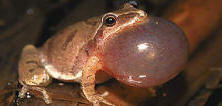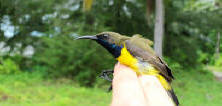|
Hunter Lab
Salisbury University - Biological Sciences
|
|||||
|
Larrea: Polyploidy, Hybridization, Germination and NDGA
Larrea collectors: Cathy VanVacter (CA), Dr. Joe McAuliffe and
Joe King (AZ), Ed Baca (NM), Dr. Joe Sirotnak (TX).
 Larrea tridentata, commonly known as the creosote bush, is a dominant plant native to the arid areas of the Southwestern region of North America and selective regions in South America (Meinzer et. al 1990). North American L. tridentata has three ploidy levels in three distinct regions: Chihuahuan Desert- diploid, Sonoran Desert –tetraploid, Mojave Desert –hexaploids. Components of L. tridentata, secondary metabolites, have been reported to have antioxidant, anti-HIV, antimicrobial, anti-tumor, and anti-hyperglycemic, and enzyme inhibitory activities (Abou-Gazar et. al 2004). Larrea tridentata, which is found throughout the shrub, has a high concentration of the antioxidant nordihydroguaiaretic acid (NDGA) (Hyder et. al 2002). The NDGA concentrations produced in the L. tridentata experience seasonal variation throughout the year, with higher concentrations seen in the winter months and lower concentrations in the summer months. Fundamental to gaining simultaneous sampling of L. tridentata samples found in the Southwest region of the United States is the establishment of a public-professional partnership. The use of a citizen science program benefits the scientists involved along with the civilian participants. Partaking in such scientific studies heightens the participating volunteer’s sense of pride and knowledge of not only their specimen but the overall field of science (McCaffrey 2005). Our goals are: 1) to analyze the seasonal variation of NDGA concentrations in accordance to the varying ploidy levels in field collected Larrea tridentata, 2) to have citizen scientists in the southwest collect monthly samples of Larrea tridentata. The main goal of the project is to maintain a strong citizen science program in order to gain access and understanding of the changes in NDGA concentrations in different environments. Citizen Science Each month, from October 2010 through September 2011, citizen scholars from locations in Arizona, California, Nevada, New Mexico, and Texas send leaf samples from native Larrea plants to our lab for analysis. Samples of 5 leaves are obtained from two plants at each location. The samples are mailed to Salisbury University in prepaid envelopes. While in the envelopes, the leaves are air dried throughout the mailing route. In order to maintain an efficient process, each volunteer is mailed a monthly reminder that a new collection of specimen for that month is sought References Abou-Gazar, H., Bedir, E., Takamatsu, S., Ferreira, D., & Kahn, I.A. (2004). Antioxidant lignans from larrea tridentata. Phytochemistry, 65, 2499-2505. Hyder, P.W., Fredrickson, E.L., Estell, R.E., Tellez, M., & Gibbens, R.P. (2002). Distribution and concentration of total phenolics, condensed tannins, and nordihydroguaiaretic acid (ndga) in creosotebush (larrea tridenata). Biochemical Systematics and Ecology, 30, 905-912. McCaffrey, R.E. (2005). Using citizen science in urban bird studies. Urban Habitats, 3(1), 70-86. Meinzer, F.C., Wisdom, C.S., Gonzalez-Coloma, A., Rundel, P.W., & Shultz, L.M. (1990). Effects of leaf resin on stomatal behaviour and gas exchange of larrea tridentata (dc.) cov. Functional Ecology, 4, 579-584. | |||||
|
|||||



